- Home
- Views On News
- Sep 13, 2022 - ITC: Load, Aim...Fire!
ITC: Load, Aim...Fire!
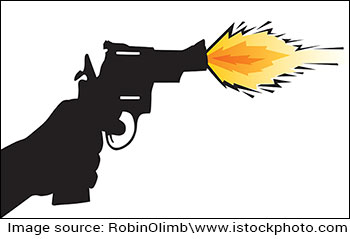
Editor's note: ITC is the biggest story in the stock market these days. The stock has gained over 50% in 2022 so far.
The recent optimism for its share price hitting multi-year high comes after several reports suggested, the company is planning to explore alternate structures for their hotel business.
What this means is ITC Hotels could soon be a separately listed entity.
The street gave a huge thumbs up to this. Many analysts too, have upped their target price and turned positive on the stock recently.
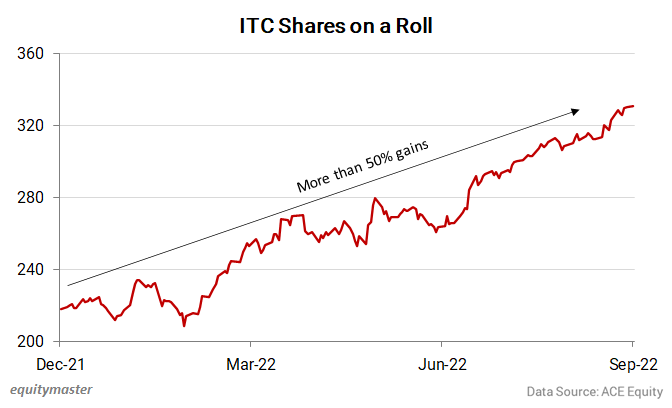
We at Equitymaster, have been bullish on ITC for quite some time. In this editorial, published in April 2022, we had highlighted what lies ahead for ITC and whether you should be excited.
Continue reading this updated article to know more...
ITC Load, Aim...Fire!
The Livingstoni Cichlid also known as Sleeper fish is a freshwater fish.
Unlike other fish, there is something very unique about this species. It has a very unusual method of attracting its prey.
It will lie down at the bottom of the ocean as if wounded. When its prey, typically smaller fish approach, it will lie quite still. And even when it's prey will take little bites of it, it will remain still.
But once the prey is close enough, it will suddenly attack and eat its surprised prey.
Looking at the stock price of ITC Ltd, one cannot think of a better analogy.
On 24 February 2012, ITC was trading at Rs 209. Fast forward ten years, the stock closed at Rs 208.30 per share on 24 February 2022.
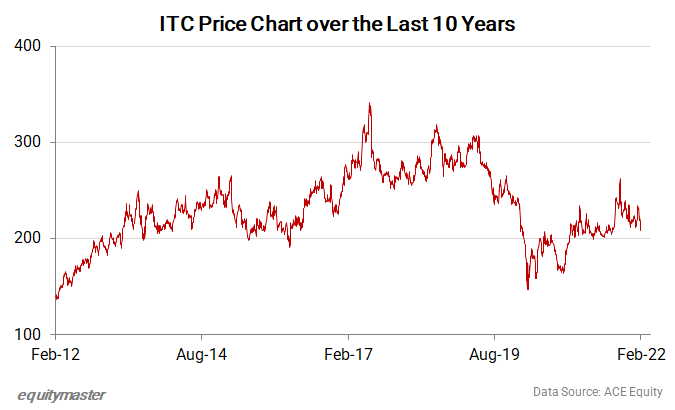
For a decade, the stock languished at levels close to Rs 200 which made it Indian social media's favourite punching bag.
Recently it's known more as a meme stock. Shareholders are largely anguished by the stock's non-performance. The company has been at the centre of furious debates and discussions among investors.
Fund managers typically don't discuss individual stock picks, but when PPFAS mutual fund, a popular value seeking fund invested in the stock of ITC in 2020, a brouhaha erupted among investors.
This forced Rajeev Thakkar, chief investment officer at PPFAS, to discuss the position in stock to calm down irate investors.
Such has been the sentiment for ITC over the last few years.
And then all of a sudden, something changed.
Since 24 February 2022, the stock has surged by almost 30% in little less than two months.
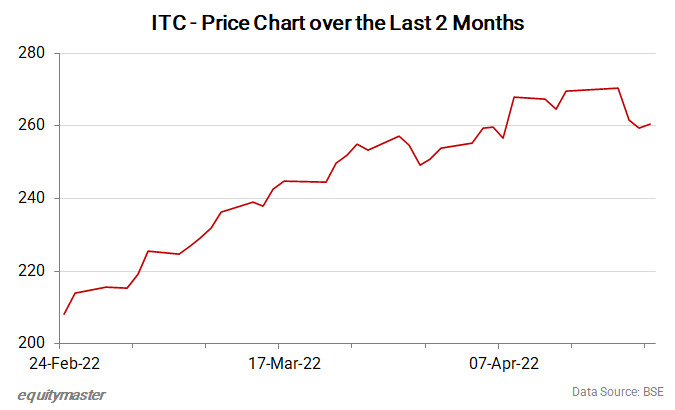
Today, the stock is close to its 52-week high having outperformed the Nifty. The street is suddenly very excited and bullish about the stock. Some analysts have put a target of Rs 450 on the stock.
But is this all too much hype too soon? Or is it like the saying goes, 'Where there is smoke, there is fire'.
Let's dig deeper...
The Smoking Gun
For a moment, let us picture ITC as a big powerful gun. This gun was loaded in the nineties, patiently and carefully aimed and calibrated over the last three decades, and finally a shot has been fired.
Load...
Loading a gun may seem like a basic concept, but many people do it wrong. When you load the ammunition incorrectly, it could cause a jam or misfire when you are shooting.
Why do good companies go bad? It's often assumed that the problem is paralysis. Confronted with a disruption in business, companies freeze. But that explanation doesn't fit the facts.
On the contrary, managers of besieged companies usually recognise the threat early and unleash a flurry of initiatives in response. For all the activity, though, many companies still falter.
The problem is not an inability to take action but an inability to take appropriate action.
In case of ITC, the management recognised the threat early. As smoking falls out of fashion with heightened regulatory scrutiny and tax hikes, it needed to diversify into other businesses.
This resulted in the company diversifying into areas such as FMCG, hotels, paperboards & packaging, agribusiness, etc.
This phase of ITC is akin to loading a bullet into a gun.
The paper boards & packaging division and hospitality business have grown considerably over the years but these revenues still contribute to less than 11% of the overall sales.
A highlight of this loading stage is the agri division's e-Choupal network. The agri-business division flagged off e-Choupal in 1990 as an IT-driven marketing channel to align farm output with market demand.
And today, it's the e-Choupal network that serves as the back-end source of raw materials that go into ITC's personal care products and packaged foods.The e-Choupal network enables ITC to source commodities at a much lower cost than its competitors. This is because it buys directly from farmers, eliminating the middle man and many levels of handling. This reduces transaction costs.
The network has also helped create a big rural sales and distribution channel for ITC. The company has used it e-Choupal to sell its FMCG products in rural India.
And although it would be difficult to quantify the profit implication e-Choupal has had on the FMCG business, it seems to be significant.
Revenues for the agri-business have grown from Rs 9.68 bn in 2001 to Rs 128.83 bn in 2021. Profits also grew from just Rs 0.11 bn to Rs 9.18 bn over the same period.
This has helped the top line of the FMCG business grow from a paltry Rs 0.22 bn in 2001 to Rs 147.57 bn in 2021.
It seems the gun was loaded with the right bullet successfully.
Aim...
The one big caveat to taking a perfect aim is that it significantly slows movement. While aiming, one has to slow down to identify and lock-on a target.
According to Newton's Third Law, every action has an equal and opposite reaction. In the case of a gun, that equal and opposite reaction is called recoil.In order to have accurate fire, one must account for the recoil and manually adjust the aim accordingly.
Since the gun has been loaded, ITC has trained all its focus on one aim - to become the largest FMCG company in India.
And just like aiming to get that perfect shot, ITC had to change its strategy many times.
The management recognised ITC was not well positioned to create long-term value in businesses such as edible oils and financial services. So they exited these businesses.
In the past, investors and analysts often questioned ITC management's capital allocation strategy for its investments in the low-margin FMCG and capital-intensive hotels segments.
In fact, 25-35% of capex every year was allocated to the hotel business, This business is known for its lower return on capital employed (ROCE).
But recently, the company has moved to an asset right model. The management has said it will only complete existing projects and not start any greenfield projects in the cash-guzzling hotels and paper businesses.
As a relatively late entrant to the FMCG industry, ITC made an aggressive entry by challenging incumbents on every single product vertical.
It competed with Hindustan Unilever (HUL) and P&G with their own line of personal care products. The company even introduced its own line of biscuits directly taking on Britannia and Parle-G.
They also took on the noodle's giant, Nestle with their own brand of instant noodles.
Although FMCG revenues now contribute to over 31% of ITC's revenues from just 0.22% in 2001, margins have been dismally low at just 2-3%. This even as some of its peers enjoy margins of 15-20%.
However, ITC has built its own products and brands from the bottom up without resorting to acquisitions in its initial years.
And this brand-building exercise takes time, huge capital outlay and perseverance.But the company has had an unwavering focus to become the largest FMCG player in India by 2030.
In 2001, over 80% of ITC's revenues were generated through tobacco. Today only 38% of its sales come from the cigarettes business.
80% of its capital employed and 90% of employees are in the non-tobacco businesses. This reflects the company's investments and commitment made over the last two decades. It believes there is still huge headroom to grow.
ITC sees huge potential for market expansion with an estimated growth between 4-5 times in key categories like snacks, biscuits, handwashes, branded aata, spices, and bodywashes over the next 15 years.
The company has leveraged its integrated its end-to-end distribution platform to widen and deepen the route to market. ITC does this via a robust multi-channel network.
It also caters to specialised segments like climate-controlled frozen foods, B2B channels for food services, as well as e-commerce.
Over the years, the company has strengthened its core channels. In the last 5 years, its market coverage increased 5 times and stockists have increased over 6 times.
ITC has already branched out from grains to processed foods and most recently into fresh farm produce. Its knowledge of the Indian market gives it an edge over foreign brands.
ITC's high-quality brands today have garnered income of over Rs 220 bn. They're present in more than 150 m households. Many of the company's FMCG brands have achieved leadership positions.
The Return on Capital Employed (ROCE) and the Earnings Before Interest and Tax (EBIT) for the FMCG segment, which were negative until 2014, have gradually increased.
But since 2018, they have more than doubled. Margins are up by 6.4% between financial years 2017 and 2021.
It looks like the long painful wait for the perfect aim may have been worth it.
Fire!
And the shot has finally been fired. Now all that's left is for the company is to follow-through.
As with many other facets of life, there's one more hurdle to mastery in the follow-through.
The follow-through is the final step in the integrated act of firing the shot. It's the glue that holds the other fundamentals together and makes firing the perfect shot possible.
From recent financial reports and the company's investor communications, it seems ITC's investment phase in FMCG and hotels is nearing completion and payback has already begun.While investments would continue in FMCG as the company is open to acquisitions, the segment is now capable of funding them on its own. This was not the case a few years back.
For the 9 months period ended 31 December 2022, the FMCG segment has generated a profit of Rs 6.96 bn.
The hospitality business which was severely hit by the pandemic has also turned a corner in the December quarter with a profit of Rs 0.53 bn against a loss of Rs 1.56 bn in the corresponding quarter.
Some FMCG brands are already generating surpluses. As these established brands progress, they will generate value which will be deployed to create newer brands with some part retained as surplus.ITC is also confident of growing its year-on-year margin by about 1%.
Looking at the synergies that ITC has in the agri business, hotels, and cuisine besides distribution, it makes perfect sense that food is the best fit for the company.Having built the base over the years, now there is more focus on value-addition.
India's potential in agriculture is immense. Experts have assessed that India's agri-exports, which currently account for only 2.5% of global share, can be doubled over time.
The recent policy measures announced by the government, once implemented, bode very well for the agri industry and particularly ITC.
The company's agri business has grown in double-digits over the last few years. It's expected to post a profit in excess of Rs 10 bn for the first time in financial year 2022.
Recently, the Russia-Ukraine conflict has sent wheat prices soaring, potentially benefiting ITC's agri division that exports wheat. It's looking to gain markets that traditionally imported wheat from Russia and Ukraine.ITC could also potentially benefit in other grain exports such as rice in case consumers start consuming more rice due to higher wheat prices.
Agri exports constitute 56% of ITC's aggregate forex earnings of US$ 7.3 bn over the last 10 years.
FMCG brand building takes time. Dabur India Ltd was established in 1884, Hindustan Unilever Ltd (HUL) in 1931, and Marico Ltd in 1994.
ITC is the latest entrant and has achieved leadership in several segments within a relatively short time compared to any of them.
Aashirvaad is the market leader in atta. Classmate is the leader in notebooks. Bingo! is #1 in the 'bridges' segment. YiPPee! is #2 in instant noodles.
When ITC launched its instant noodles, YiPPee! in 2010, Nestle's Maggi had a near monopoly with a market of over 90%. In just over a decade, YiPPee! has close to 25% of the market share.
The company has been relentlessly pursuing leadership and higher market share with sustained investment and continuous innovation.
Savlon which was acquired from Johnson & Johnson in 2015 has grown over 13 times and become another Rs 10+ bn brand in a little over 5 years.Another acquisition, neem-based natural floor cleaner, Nimyle, has grown nearly 4x.
Recently, ITC acquired spices manufacturer, Sunrise Foods Pvt Ltd, its biggest acquisition till date.It's estimated the branded spices market will double by 2025 to Rs 500 bn.Sunrise is a market leader in eastern India and this acquisition will enable ITC to address the growing opportunities in branded spices in underpenetrated markets.
Coming to Valuations...
If you look at valuations for FMCG companies, HUL has a PE (price to earnings ratio) of 59. Marico trades at a PE ratio of 60. Dabur is at 68 PE.
On the other hand, even with the recent rise in price, ITC's PE is just 22.
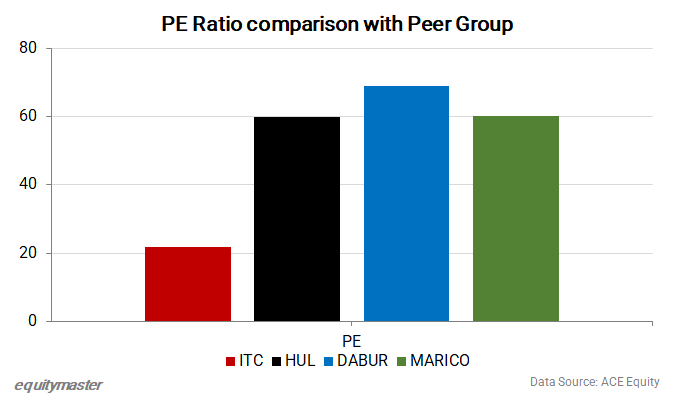
It's clear the company is still not regarded as an FMCG major by investors.
But the numbers show the company's FMCG business continues to scale rapidly and ITC is now the second largest FMCG player in India by revenue.
Through all the trolling and negative news over the last few years, ITC has demonstrated resilience.
And let us not forget the cigarette vertical of ITC is a cash cow unmatched in corporate India. While it may decline, it's still a thriving business.
A lot of its investments in new businesses are getting concluded as the foundation has now been laid. Hence incremental investments in the future will not be as much.
Recently, there is a gradual change in perception due to the considerable growth in non-tobacco revenues and profits. This indicates the company was ultimately right in its strategy to diversify into these new businesses.
The shot has been fired and ITC has finally exited a painful decade.
Que Será, Será?
Over the last decade, ITC's diversification efforts have failed to boost its stock price. Investors have been concerned about high cigarette taxes, ESG headwinds, diverging global trends and an underperforming FMCG business.
But it seems the worst is behind the company.
In a research note, Morgan Stanley expects FMCG profit contribution to gradually increase to 8.5% and 12% over the next 5 and 10 years, up from 3% currently. They estimate margins will improve to 11% and 17.6% by FY25 and FY35.It also expects the FMCG business to contribute to dividends over the next 5 years.
Another concern has been the uncertainty over high cigarette taxes as taxes were increased by over 150% between 2010-19.The Union Budget 2022 did not changed taxation on cigarettes for the second consecutive year, Thus going forward, tax increases could be more reasonable.
Since 2018, institutional investors have placed a high value on ESG factors. This has hurt the global tobacco sector in general.
But ESG is something that is evolving. Investors are beginning to understand that ESG is not simply about exclusion but rather it's about the manner in which companies conduct business.
ITC carries a very unique global distinction of being carbon positive for 16 years, water positive for 19 years, and has been following solid waste recycling policy for 14 years now.
About 41% of its total energy consumption comes from renewable energy. The company aims to completely meet its electrical energy needs from renewable sources by 2030.ITC's e-Choupal services today have benefitted over four million farmers. Its women economic empowerment program has created over 80,000 sustainable livelihoods for women. Its primary education program has benefitted over 775,000 children.
Turnover from the tobacco business now accounts for only 38% of its total revenues. As per a global ESG rating co, Sustainalytics, ITC is ranked #1 among global tobacco companies and #3 overall on ESG performance in the foods products industry.
The company has been recently included in the Dow Jones Sustainability Emerging Markets Index.
So, ITC actually ranks among the top companies in the world in ESG.
The ITC stock has not done much over the last decade. However, when you look at various stocks, this happens due to excessive valuation in the past or just stagnation at the same levels due to a low growth scenario.In fact, if one was to look at Hindustan Unilever (HUL), it went through such a patch from 2002 to 2007. This happened even though it coincided with one of the strongest bull runs in the Indian equity markets.
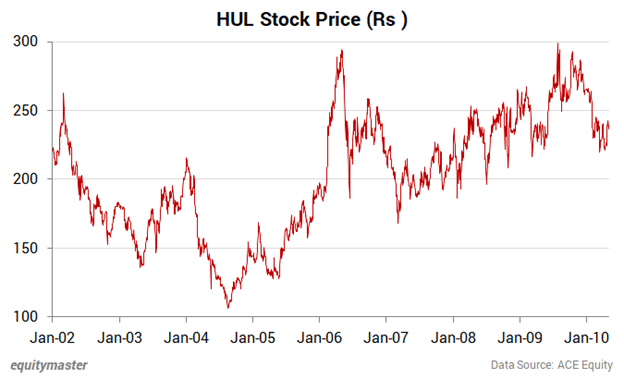
HUL was a big underperformer. Between 2002 and 2007, the Nifty went up over
250%. In the same period, HUL was actually down 19%.
But for the next 5-year period between 2007-2012, HUL was up 97% while the Nifty being down 6.5%.
Value seeking investors know that it makes sense to pick up a fundamentally strong stock which has underperformed over 3-5 years rather than just buying a stock at a 52-week low.
Analysts and experts know how to forecast the future. But its 100-year-old companies like ITC that know what action they must take in the present to make their own future.
ITC put all its weight behind its FMCG business. Was it enough? Only time will tell...
Disclaimer: This article is for information purposes only. It is not a stock recommendation and should not be treated as such. Learn more about our recommendation services here...

Yazad Pavri
Cool Dad, Biker Boy, Terrible Dancer, Financial writer
I am a Batman fan who also does some financial writing in that order. Traded in my first stock in my pre-teen years, got an IIM tag if that matters, spent 15 years running my own NBFC and now here I am... Writing is my passion. Also, other than writing, I'm completely unemployable!
Equitymaster requests your view! Post a comment on "ITC: Load, Aim...Fire!". Click here!
2 Responses to "ITC: Load, Aim...Fire!"
Devendra Verma
Sep 13, 2022Excellent writing Yazad. Keep it up. It was really a refreshing article in the EM. Well I had seen your analysis few months back on youtube for ITC.
Cheers


Makarand Joshi
Oct 8, 2022Dear Pavri Sir,
An excellent paper. Such clarity could come only from a passionate writer. I am lucky to have seen your youtube videos just 2 days back, all great. Salute to your research & style! keep it up.